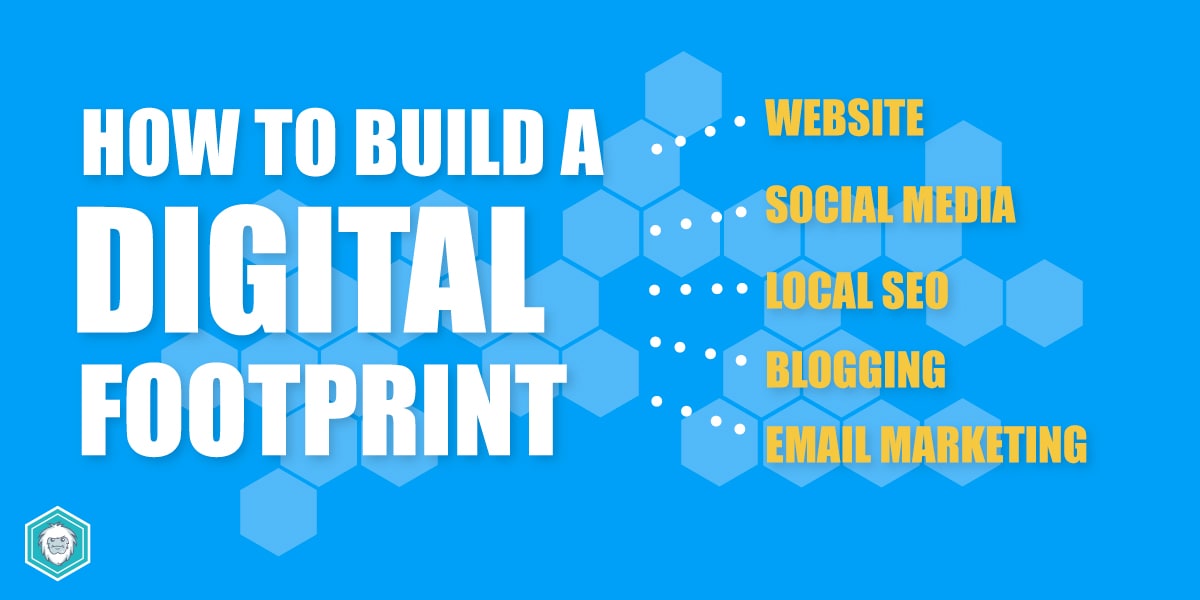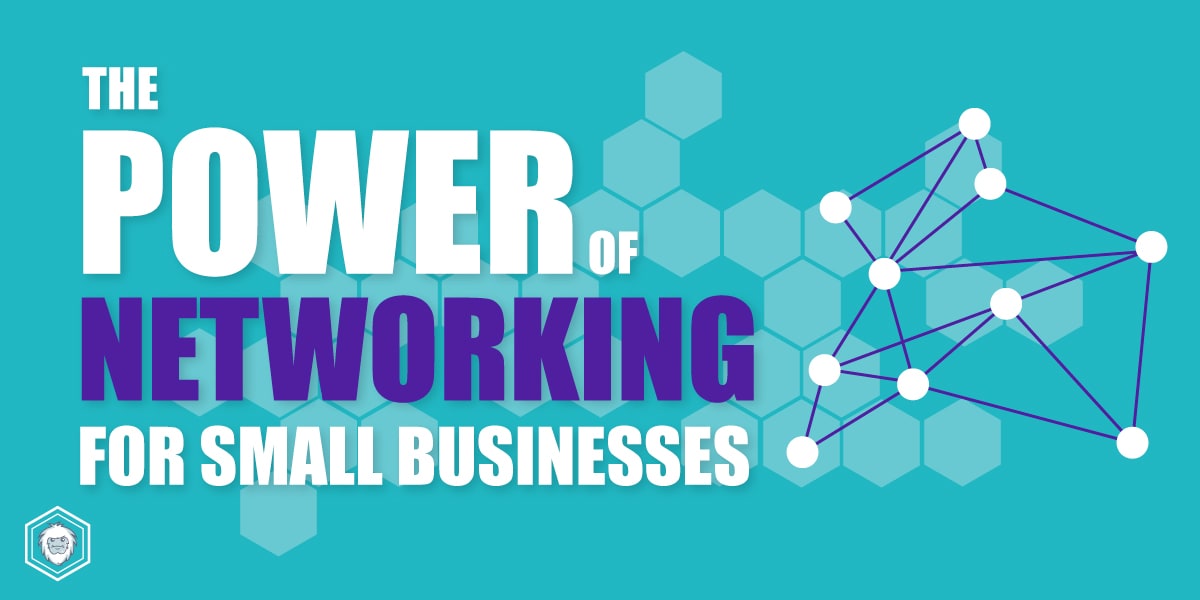Using Customer Feedback to Fuel Business Growth: A Guide for Success
Customer feedback is one of a business’s most valuable assets. It offers insight into how your customers perceive your products or services and empowers you with actionable data that can guide decisions and fuel business growth, putting you in the driver’s seat of your business’s success.
Whether you’re a small business owner or part of a larger company, using customer feedback can help you identify strengths, address weaknesses, and innovate in ways that meet your customers’ evolving needs.
In this post, I’ll explore the importance of customer feedback, share popular tools for gathering it, and offer tips and strategies on how to use feedback to drive growth.
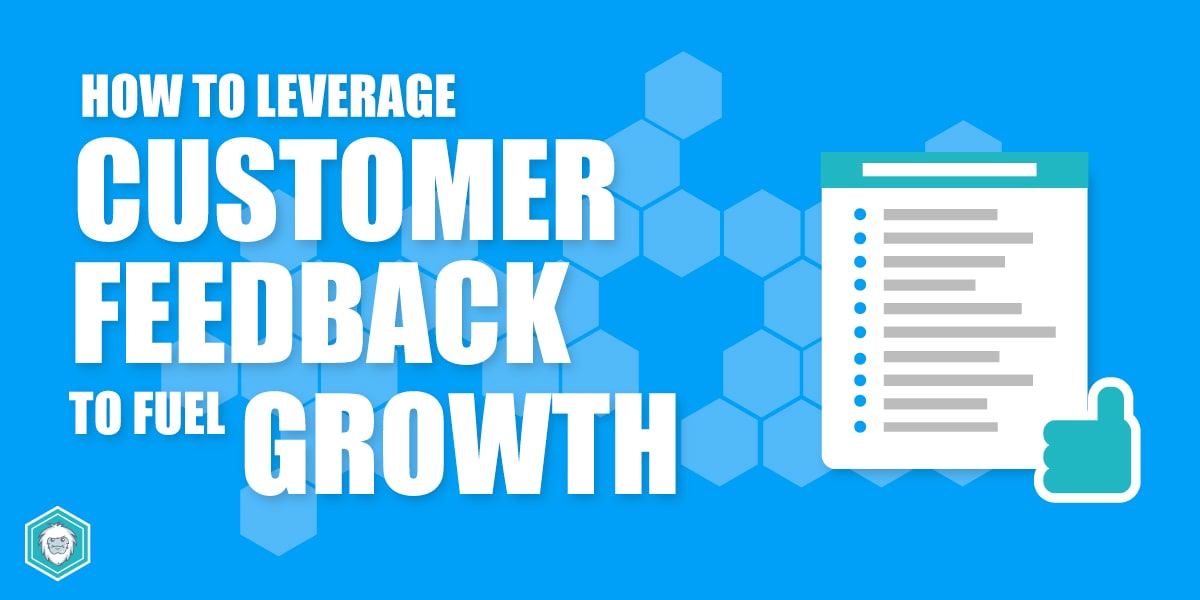
Why Customer Feedback Matters
Why is customer feedback important for business?
Listening to what your customers are saying helps provide you with the data you need:
- Improve Customer Satisfaction: When you seek out and act on customer feedback, it shows that you value their opinions. This builds trust and strengthens your customer relationship, leading to improved satisfaction.
- Increase Retention Rates: Companies that listen to customer feedback can adapt quickly to changing expectations, which helps retain existing customers. After all, keeping loyal customers is more cost-effective than acquiring new ones.
- Improve Products and Services: Feedback helps you improve the things you offer, making them more in line with what your customers want.
- Identifying Trends: Analyzing feedback, businesses can spot trends in customer preferences or concerns. This allows them to pivot and innovate proactively rather than reactively.
- Enhanced Brand Loyalty: When customers see that their feedback leads to positive changes, they feel more connected to your brand. This loyalty can translate into repeat business and referrals.
Popular Tools for Gathering Customer Feedback
Numerous tools are available to gather feedback from your customers, which you use down to the data you want to collect.
If you’re collecting data through surveys, social media, or direct interactions, the right tool will help simplify the process and provide valuable insights.
Here are some of the most popular customer feedback tools:
1. SurveyMonkey: A Powerful Tool for Customizable Surveys
SurveyMonkey is an online platform for creating customizable surveys. Businesses of all sizes trust it to gather valuable feedback from visitors to your site.
SurveyMonkey’s user-friendly interface and customization options allow the design of surveys tailored to specific customer segments, ensuring that questions resonate with the target audience.

Businesses of any size can create various types of surveys, from customer satisfaction and product feedback to market research and employee engagement.
One of SurveyMonkey’s standout features is its ability to track responses in real time, giving businesses instant access to data.
Its advanced analytics tools can help uncover trends and patterns, enabling you to make informed, data-driven decisions that align with your business goals.
Whether you’re measuring customer satisfaction, identifying pain points, or planning new strategies, SurveyMonkey provides the flexibility and precision needed for effective campaigns.
Whether customers visit your site on mobile or desktop, mobile compatibility allows you to reach respondents on any device, maximizing engagement and response rates.
Pros:
- Customizable survey templates for different needs
- Advanced analytics and reporting features
- Allows for segmentation of respondents
- Integration with other tools like MailChimp, Salesforce, and more
Cons:
- Some advanced features require a paid plan
- Limited customization options on the free version
- Can become costly for larger teams or frequent surveys
2. Google Forms: A Cost-Effective Survey Tool for Small Businesses
One of the best free survey tools online has to be Google Forms.
It makes creating and distributing surveys easy while remaining free to use, making it a viable solution for small businesses on a budget.
Its intuitive interface allows you to design surveys quickly, whether for gathering customer feedback, conducting market research, or managing employee input.
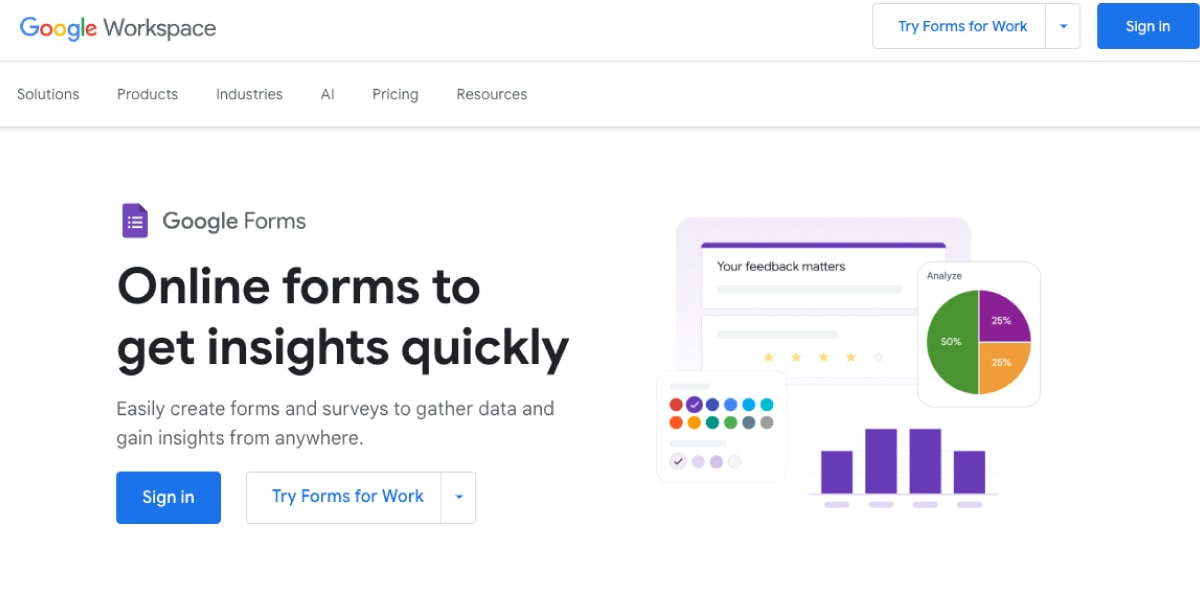
The platform offers a range of question formats, including multiple-choice and open-ended responses. You can pick and choose which format to use, providing flexibility to tailor surveys as needed.
One of Google Forms’ key strengths is its seamless integration with other Google Workspace apps, such as Google Sheets and Google Drive. This makes it convenient for analyzing data and storing responses in one location.
Like SurveyMonkey, Google Forms is mobile-friendly. It allows users to access surveys across devices and helps boost response rates.
For small businesses seeking a cost-effective, reliable way to gather insights into their customer’s needs, Google Forms delivers functionality and efficiency without the added expense.
Pros:
- Completely free to use
- Easy integration with Google Sheets for data analysis
- Simple interface that’s easy for both creators and respondents to navigate
- No need for additional software or subscriptions
Cons:
- Lacks some advanced survey features compared to paid tools
- Limited customization options for branding
- No in-depth analytics or reporting capabilities
3. Zendesk: A Comprehensive Solution for Customer Feedback and Support
Zendesk is a widely recognized customer service platform that doubles as a tool for collecting and analyzing customer feedback.
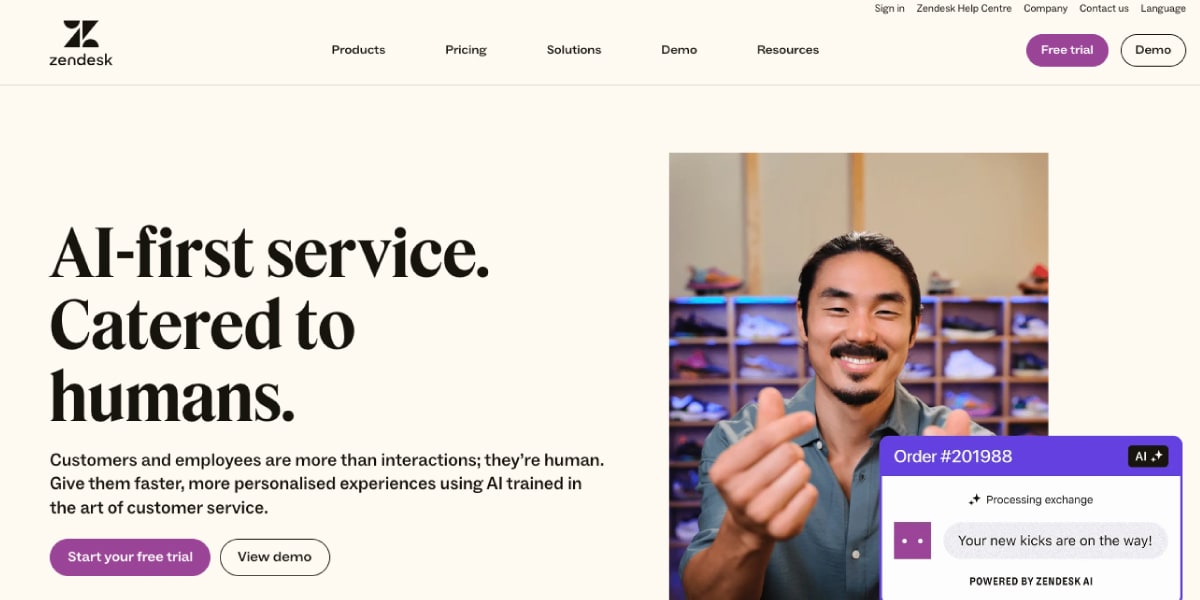
By integrating feedback from support tickets, live chats, and emails, Zendesk centralizes customer interactions, allowing businesses to manage inquiries and insights in one place.
This approach helps businesses quickly address customer concerns and spot common trends or potential issues.
One of Zendesk’s standout features is its ability to blend customer support and feedback collection. As customers engage with your support team, their responses can be transformed into data to help you understand their pain points and expectations.
With built-in analytics and reporting tools, Zendesk enables businesses to track key metrics like satisfaction rates and recurring feedback themes.
Overall, Zendesk provides an all-in-one platform to advance both service quality and data-driven decision-making in businesses.
Pros:
- Excellent for managing support tickets and customer feedback in one platform
- Robust automation features for streamlining support
- Multi-channel support (email, chat, social media, etc.)
- Provides insights into customer service performance
Cons:
- More suited for customer support than purely feedback collection
- Can be expensive for small businesses or those on tight budgets
- Steeper learning curve due to its broad feature set
4. Qualtrics: An Enterprise-Level Feedback and Analytics Powerhouse
Qualtrics is a leading feedback platform designed for businesses that require advanced survey capabilities and detailed analytics to inform strategic decisions.
Known for its enterprise-level functionality, Qualtrics empowers organizations to design intricate surveys that gather in-depth insights across various touchpoints, from customer experiences to employee satisfaction.
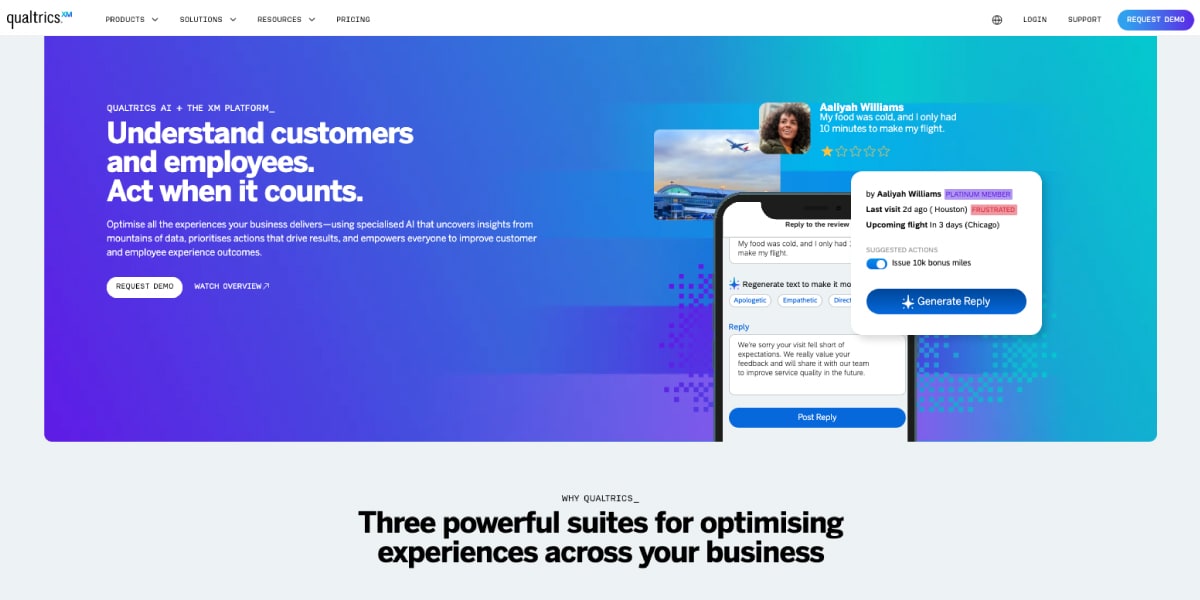
Its robust customization options allow businesses to tailor surveys to specific audiences and objectives, ensuring the data collected is highly relevant and actionable.
What sets Qualtrics apart is its cutting-edge analytics suite, which transforms raw feedback into meaningful insights through features like predictive analytics, text analysis, and real-time reporting.
These tools help businesses identify trends, anticipate customer needs, and measure the impact of their strategies.
If you want to prioritize data-driven decision-making, Qualtrics is a great solution. It can help drive growth, enhance customer experiences, and increase employee engagement.
Its scalability ensures it adapts to businesses of all sizes, making it an essential tool for long-term success.
Pros:
- Advanced survey design options with analytics built-in
- Customizable to fit specific business needs
- Real-time data reporting and segmentation
- Integrates with a wide range of business software
Cons:
- Expensive, making it more suitable for larger enterprises
- Overwhelming for smaller businesses or teams without dedicated resources
- Long setup time for advanced features
5. Yotpo: A Specialized Tool for E-Commerce Reviews and Feedback
Yotpo empowers businesses to collect and display customer reviews and ratings with ease. It integrates seamlessly with ecommerce platforms like Shopify, WooCommerce, and Magento, streamlining post-purchase feedback collection.
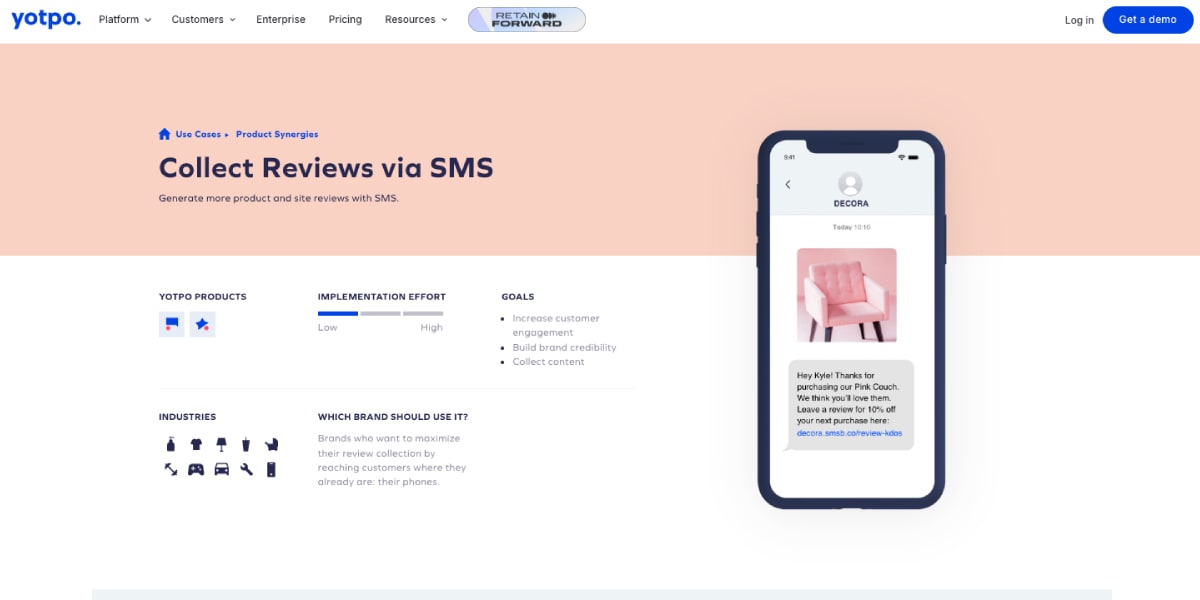
Online stores can automatically request customer reviews, ensuring a steady flow of authentic testimonials that build trust and credibility.
One of Yotpo’s standout features is its ability to display reviews directly on product pages, which helps boost conversion rates and improve search engine visibility.
In addition to product reviews, Yotpo supports photo reviews, ratings, and Q&A sections, providing insightful information for prospective buyers. Its advanced analytics provide insights into customer sentiment and feedback trends, giving businesses the data they need to refine their products.
For e-commerce businesses looking to leverage customer feedback to build trust and drive sales, Yotpo is an essential and user-friendly solution.
Pros:
- Excellent for collecting customer reviews and ratings
- Seamless integration with e-commerce platforms
- Allows businesses to display reviews on product pages
- Includes tools for social proof and marketing campaigns
Cons:
- Primarily designed for e-commerce, limiting its use for other business types
- Some features require a paid subscription
- Can be difficult to manage if you have many products or services
6. Trustpilot: Building Social Proof Through Customer Reviews
Trustpilot is one of the most well-known platforms for collecting and showcasing customer reviews.
These reviews help businesses build credibility and trust among potential customers, which, in turn, makes it simple for companies to gather authentic feedback from their audience.

With this method of gathering customer feedback, you can consistently receive reviews that offer valuable insights into customer satisfaction and experiences that might otherwise go unnoticed.
What makes Trustpilot stand out is its broad and engaged user base, which makes it a great tool for building social proof. Featuring Trustpilot reviews on your website or in marketing materials helps reassure potential customers that your business is trustworthy and dedicated to quality.
Trustpilot also provides analytics that track customer sentiment, allowing you to spot trends and pinpoint areas where you can improve. For businesses aiming to improve their reputation, boost conversions, and earn trust in a competitive environment, Trustpilot offers a simple yet effective solution with tangible results.
Pros:
- Established user base increases visibility
- Automates the review collection
- Easy to integrate with various e-commerce platforms
- Helps improve brand reputation through social proof
Cons:
- Premium features are locked behind paid plans
- Customer reviews may not always be 100% authentic
- Reputation can be affected by negative reviews, which may be harder to manage
Strategies for Using Customer Feedback to Drive Growth
Collecting feedback is only half the battle; using it effectively is where businesses can truly unlock growth potential.
Here are some strategies to ensure you’re making the most out of your customer feedback:
1. Create Actionable Insights
Once you’ve gathered customer feedback, it’s necessary to analyze it properly. Break down feedback into common themes or issues. For example, if multiple customers mention long wait times for customer support, investing in more staff or automated systems may be time-consuming.
Example:An online clothing retailer receives feedback that customers find it difficult to navigate the website. After analyzing this feedback, the business decided to revamp the website layout, making it more user-friendly, which increased conversion rates.
2. Implement Changes Based on Feedback
One of the most important aspects of using customer feedback is taking action. Customers want to know that their opinions matter. Implementing changes based on their feedback strengthens your brand’s reputation for being responsive and customer-centric.
Example:A restaurant chain receives feedback about slow service during peak hours. In response, they implement a more efficient ordering system, hire additional staff, and improve their training process. The result is faster service and higher customer satisfaction.
3. Create Feedback Loops
Feedback loops allow businesses to continuously collect, review, and act on customer feedback. When you close the loop by updating customers on the changes made as a result of their feedback, you show them that you value their input and foster continued engagement.
Tip: Incorporate “We Heard You” messages in your communication, whether it’s through email newsletters, social media, or on your website. For example, “Thanks to your feedback, we’ve made our checkout process faster—try it out and let us know what you think!”
4. Prioritize the Most Impactful Feedback
While listening to all feedback is important, not every suggestion will be equally beneficial for your business. Prioritize feedback that aligns with your business goals or addresses widespread issues that affect many customers.
Example:A software company may receive customer feedback about a minor feature bug. However, if many customers report app speed issues, that should become a higher priority for the development team.
5. Engage with Customers Directly
Make sure your customers know you’re listening to them. Respond to feedback, whether it’s positive or negative, and show customers that their opinions have led to meaningful changes. Engage with them on social media, email, or live chat to strengthen relationships.
Tip: Personalize your responses. Instead of generic replies, acknowledge the specifics of their feedback and let them know what you plan to do with the information.
6. Use Feedback to Innovate
Don’t just fix problems—use customer feedback as a springboard for innovation. Customers often share ideas that can be used to develop new products or services that they are willing to purchase in the future.
Keep an open mind and be willing to experiment with ideas suggested by your audience.
Example: A fitness brand that gathers customer feedback about workout preferences might use this information to develop a new line of fitness equipment tailored to customer needs. By innovating in this way, the brand can differentiate itself from competitors.
Conclusion: Making Customer Feedback Part of Your Growth Strategy
You can use customer feedback to gather data that, in turn, help give you the knowledge you need to improve the products you promote and the customer experience.
Business growth is a by-product of this, as the more positive reviews you get, the more potential customers you will receive.
Choosing the right tools is just the start. You’ll then need to take the time to analyze the feedback you receive to help implement effective strategies.
This is a continuous cycle, and you’ll need to review feedback regularly to see if what you’re implementing is working. By engaging like this and listening to your consumers, you can build a business that’s not only responsive but also resilient and forward-thinking.
The key is to view customer feedback as a resource rather than a task and to integrate it into your overall business strategy for long-term growth.
Start listening to your customers today, and you’ll be well on your way to creating a business that thrives on valuable insights and continuous improvement.


